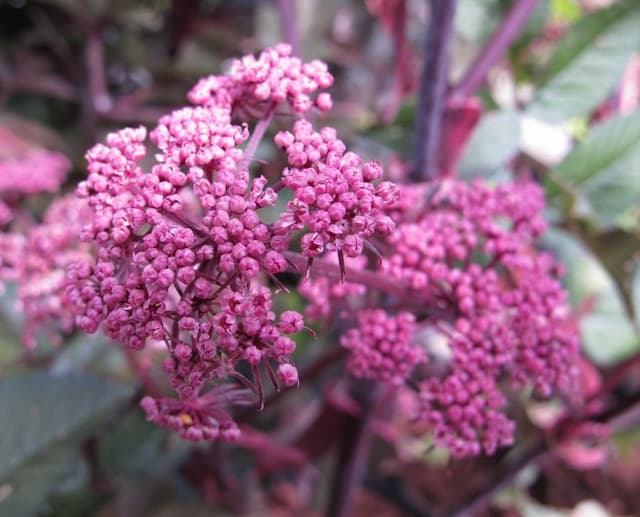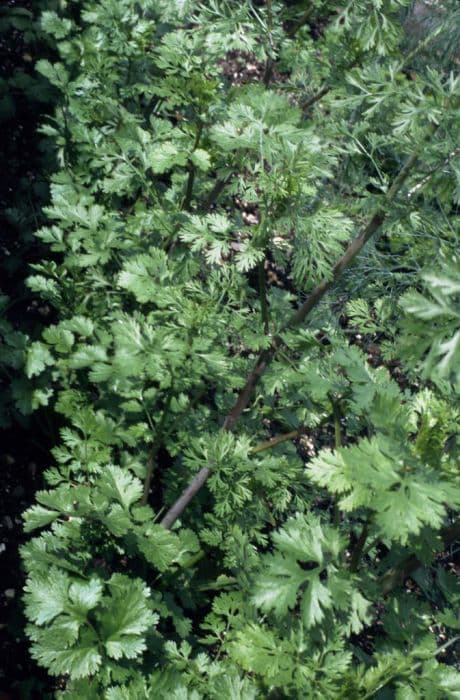Coriander Coriandrum sativum

ABOUT
Coriandrum sativum, commonly known as cilantro or coriander, is a delicate herb with a distinct appearance. It has deep green, lacy leaves that are divided into broad, flat segments, resembling Italian parsley, but they are more tender and have a unique aroma. The plant bears small, delicate flowers that cluster together in groups called umbels. These flowers are usually white or very light pink in color. The slender stems of the plant are also green and can have a slightly grooved texture. Following the flowering stage, the plant produces tiny, round fruits, known as coriander seeds, which are commonly used as a spice. The overall appearance of cilantro is feathery and light, with a fresh, pungent scent that is easily recognizable in culinary uses.
About this plant
 Names
NamesFamily
Apiaceae.
Synonyms
Coriander, Cilantro, Chinese Parsley, Dhania.
Common names
Selinum coriandrum, Coriandrum diversifolium, Coriandrum globosum, Coriandrum majus, Coriandrum sativum.
 Toxicity
ToxicityTo humans
Coriander, also known as cilantro, is generally considered safe for human consumption. It is widely used as a culinary herb and spice in various cuisines around the world. However, some individuals may experience an allergic reaction to coriander, which could result in symptoms such as hives, itching, or swelling. In very rare cases, a severe allergic reaction known as anaphylaxis may occur, which requires immediate medical attention. Aside from these allergic reactions, coriander is not toxic to humans and does not typically cause poisoning when ingested in normal food amounts.
To pets
Coriander, known as cilantro, is not toxic to pets such as dogs and cats. It is generally considered safe for them to consume in small amounts. However, like in humans, some pets may have an allergic reaction to coriander, though this is rare. If a pet ingests coriander and has an allergic reaction, the symptoms might include gastrointestinal upset, such as vomiting or diarrhea. If these symptoms occur, it is advisable to consult a veterinarian. Otherwise, there are no known toxic effects of coriander on common household pets.
 Characteristics
CharacteristicsLife cycle
Annuals
Foliage type
Deciduous
Color of leaves
Green
Flower color
White
Height
1-2 feet (30-60 cm)
Spread
1 foot (30 cm)
Plant type
Herb
Hardiness zones
2-11
Native area
Mediterranean
Benefits
 General Benefits
General Benefits- Culinary Uses: Coriander, also known as cilantro, is extensively used in cooking for its fresh leaves and dried seeds, adding flavor to dishes.
- Nutritional Content: Rich in vitamins and minerals, it's a good source of Vitamin C, Vitamin K, and dietary fiber.
- Decorative: Its delicate leaves and small flowers can add an ornamental touch to gardens and window boxes.
- Companion Planting: Coriander can be beneficial in gardens as it may help repel certain pests when planted near vegetables.
- Herbal Uses: The leaves and seeds are used in traditional herbology for non-medical purposes, like flavoring for homemade remedies and teas.
 Medical Properties
Medical Properties- Antioxidant: Coriander contains antioxidants, which can neutralize free radicals responsible for aging and various chronic diseases.
- Antidiabetic: Some studies suggest that coriander seeds can help lower blood sugar levels, which may be beneficial for diabetes management.
- Antimicrobial: Coriander has been shown to have antimicrobial properties that can inhibit the growth of certain bacteria and fungi.
- Anti-anxiety: Some research indicates that coriander extract might have anxiolytic effects similar to anti-anxiety medications.
- Digestive aid: Coriander is often used to settle digestive upset and to aid in soothing gastrointestinal discomfort.
- Lipid-lowering: Components in coriander may help to reduce LDL (bad cholesterol) levels and increase HDL (good cholesterol) levels in the blood.
- Anti-inflammatory: As a traditional medicinal herb, coriander has been used for its anti-inflammatory properties to alleviate symptoms in inflammatory disorders.
- Menstrual cycle regulation: Coriander seeds are traditionally used to regulate menstrual cycles and relieve related cramping.
- Detoxification: Coriander is sometimes considered a detoxifying agent, used to remove heavy metals and other toxic agents from the body.
 Air-purifying Qualities
Air-purifying QualitiesThis plant is not specifically known for air purifying qualities.
 Other Uses
Other Uses- As a natural dye: Coriander seeds can be used to produce a natural dye for fabrics, offering a range of tan and brown hues depending on the mordant used.
- In perfume making: Coriander essential oil, derived from its seeds, is occasionally used as a fragrance component in perfumes, lending a spicy, woody note.
- Culinary garnish: Coriander leaves are often used as a decorative garnish on culinary dishes, adding a fresh appearance and a hint of flavor.
- As a flavoring agent in liqueurs: The seeds are used to impart a distinct flavor to certain types of alcoholic liqueurs and spirits, such as some gin varieties.
- In candle making: Coriander oil can be added to candles to give them a refreshing and soothing fragrance when burned.
- As a natural pest deterrent: Coriander can be planted as a companion plant in gardens to help repel aphids and potato beetles.
- In handmade soaps: Ground coriander seeds or coriander essential oil is used in soap making to add exfoliating properties and fragrance.
- In baking: Beyond savory dishes, coriander seeds are sometimes used in sweet baked goods like cakes and pastries for an unexpected flavor twist.
- As a potpourri ingredient: Dried coriander leaves and seeds are used in potpourri mixtures to add a refreshing scent to rooms.
- In relaxing bath blends: The essential oil or fresh leaves may be used in bathwater for a fragrant and relaxing soak.
Interesting Facts
 Feng Shui
Feng ShuiCoriander is not used in Feng Shui practice.
 Zodiac Sign Compitability
Zodiac Sign CompitabilityCoriander is not used in astrology practice.
 Plant Symbolism
Plant Symbolism- Love and Lust: Coriander, also known as cilantro, has been traditionally used in love spells and potions, suggesting it can attract love or enhance libido.
- Health and Healing: Coriander is known for its medicinal properties, symbolizing physical and emotional healing.
- Protection: Some cultures believe that coriander can provide protection against illness and evil spirits when used in amulets or consumed.
- Eternal Life: Because of its preservative qualities, coriander has been used in the embalming process, symbolizing the idea of immortality or eternal life.
- Peace: Its calming scent and flavor are sometimes associated with bringing peace and calmness to a home or individual.
 Water
WaterCilantro requires consistent moisture and should be watered when the top inch of soil feels dry to the touch, approximately every 3 to 7 days, depending on the climate and weather conditions. Use gentle, deep watering to ensure the roots receive adequate moisture, which typically means using about 1 inch of water per week. Overhead watering is not ideal as it can promote disease; instead, water at the base of the plant. During hot, dry periods, watering frequency may increase, and it's always better to water in the morning to reduce evaporation and give the plants time to dry out during the day.
 Light
LightCilantro thrives in full sun but can tolerate some light shade, especially in hotter climates. The best spot for this plant is an area that receives at least 6 to 8 hours of sunlight per day. However, in regions with very hot summers, providing afternoon shade will help prevent the plant from bolting, or going to seed too quickly.
 Temperature
TemperatureCilantro grows best in cooler conditions and can tolerate temperatures between 50°F and 85°F. The ideal temperature range for cilantro is between 60°F and 70°F. While it can survive a light frost, temperatures dipping below 50°F or soaring above 85°F can cause the plant stress or promote bolting.
 Pruning
PruningPruning cilantro is primarily done to delay bolting, or the production of flowers and seeds, which causes the leaves to become more bitter. Snip off the top part of the cilantro plant to promote bushier growth and remove any flower stalks as soon as they appear. Pruning can be done every few weeks during the growing season to prolong harvesting, and the best time for this task is in the morning when the plant is most hydrated.
 Cleaning
CleaningNot needed
 Soil
SoilCilantro prefers a well-draining, fertile soil with a pH between 6.0 and 6.8. A mix of three parts garden soil with one part sand or perlite should provide good drainage and aeration. Organic matter such as compost can be added to enrich the soil nutrients.
 Repotting
RepottingCilantro rarely needs repotting as it is a short-lived herb. It is best sown directly where it is to grow, but if started in pots, transplant young cilantro plants early before they become root-bound.
 Humidity & Misting
Humidity & MistingCilantro thrives in moderate humidity levels. If the ambient humidity is too low, periodic misting can help, but it is not a plant that requires high humidity environments.
 Suitable locations
Suitable locationsIndoor
Place in bright, indirect light and keep soil moist.
Outdoor
Plant in full sun to part shade and water regularly.
Hardiness zone
2-11 USDA
 Life cycle
Life cycleCoriander, also known as cilantro, begins its life cycle with seed germination, which occurs in mild temperatures and takes about 7-10 days. After germination, the seedlings develop into small plants with characteristic lacy leaves. During the vegetative stage, coriander plants grow rapidly and form a rosette of leaves close to the ground. Following the vegetative phase, coriander enters the bolting stage, where it grows a tall stem that will eventually produce flowers. The flowering stage is characterized by white to pale pink umbel-shaped flowers, which are attractive to pollinators and lead to the production of fruit. The final stage is seed maturation, where the fruits dry and contain seeds that can be harvested for culinary use or to plant the next generation of coriander.
 Propogation
PropogationPropogation time
Spring to summer
Propogation: Coriander, also known as Coriandrum sativum, is most commonly propagated through seeds. The ideal time to sow coriander seeds is in late spring to early summer when the soil temperature has reached at least 55°F (13°C). To propagate, sow the seeds directly into the soil about 1/4 inch (6 mm) deep, spacing them about 4 to 6 inches (10 to 15 cm) apart. Water the area gently but thoroughly after planting. Seeds typically germinate within 7 to 10 days. Thin the seedlings to space them out for better air circulation and growth, which is key to prevent diseases and encourage a good yield. Coriander is typically grown as an annual, so saving seeds from the previous year's crop can ensure a continual supply.








